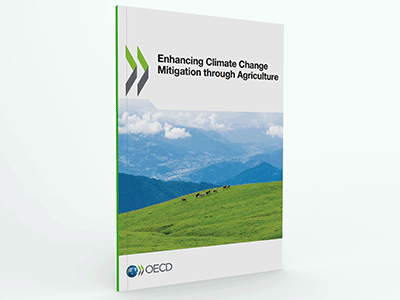Climate change and food systems
Climate change and the policy implications for agriculture and fisheries
Climate change is one of the greatest challenges of our era. Rising temperatures and sea levels, changes in rainfall patterns and water temperatures, ocean acidification and more frequent and intense extreme weather events, will all affect how and where we produce our food.
Food production systems need to adapt to climate change
Climate change will increase pressure on land and water while reducing yield growth, with the exception of only a few regions. Productivity is expected to decrease for about half of fisheries worldwide as a result of climate change impacts on stock productivity and on fish migration patterns. This will hurt the tropics the most, but also OECD fisheries.
Over time, farmers, aquaculture producers and fishers will be under increasing pressure to adapt their practices and technologies to meet these challenges. While there is much that people can do on their own, in the worst cases, government policies will be essential to successful climate change adaptation.
Ongoing OECD work looks into how inclusive and science-based policy-making processes can best support the adoption and implementation of needed policies such as disaster recovery and catastrophic insurance as well as policies to improve co-operation, preparedness, and resilience.
Food policy must take climate change into account
Since the Paris Agreement from the 2015 United Nations Climate Change Conference (COP 21), stronger mitigation efforts are being embraced worldwide to slow down and stabilise global warming. Many countries have revisited their mitigation plans to strengthen their effectiveness or to find new solutions.
The agriculture sector, together with forestry and other land uses, contributes nearly a quarter of all anthropogenic greenhouse gas emissions (GHGs). Half of this share comes from direct agricultural emissions, mainly from livestock, with most of the rest from deforestation of which agriculture is the main driver. Emissions from the global fishing industry are only 4% of emissions from food production but grew by 28% between 1990 and 2011, with little coinciding increase in production.
Emission reductions from food production have so far received less attention in GHG mitigation policies than those from energy, transport and other industrial sectors; consequently emissions from agriculture could become the dominant source of global emissions by mid-century. Therefore, meeting the Paris Agreement’s targets to limit global temperature increases to 1.5°C or well below 2°C, will be impossible without the sector doing its part to tackle climate change.
OECD work identifies policy solutions that can unlock the large mitigation potential of food production, while helping to minimise the economic impacts on the agri-food sectors and consumers. Policies at the international, national and sector levels must work together to avoid simply shifting carbon emissions from one place to another. In low-income countries, all this must be accomplished without threatening food security.
Latest update
Enhancing Climate Change Mitigation through Agriculture
Agriculture, with its growing contribution to global greenhouse gas emissions and opportunities to mitigate emissions, can help close the gap between existing global mitigation efforts and those that are needed to keep global warming to between 1.5 °C and 2 °C by the end of the century. Global scale and farm scale analyses are used to evaluate both the effectiveness of different policy options to reduce agricultural emissions, and the impact on competitiveness, farm income, food security, and government finances.
Ag, fish and climate change publications
Read all OECD publications on climate change, agriculture and fisheries on the OECD iLibrary.
Agriculture and fisheries publications
All of our food, agriculture and fisheries research and analysis is available to read online for free on the OECD iLibrary.
Sign up for our newsletter
Sign-up to our agriculture newsletter to receive periodic e-mail updates on new publications, videos and analysis.
Contact us with your questions
If you have questions about OECD research and analysis on agriculture, please feel free to contact us directly.
